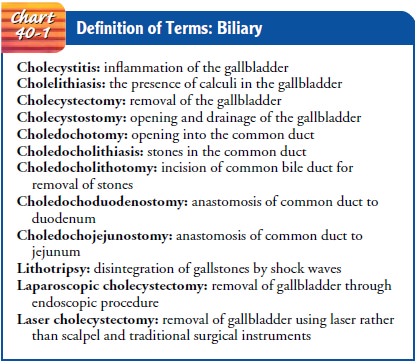Chapter: Medical Surgical Nursing: Assessment and Management of Patients With Biliary Disorders
Cholecystitis - Disorders of the Gallbladder
Disorders of the Gallbladder
Several
disorders affect the biliary system and interfere with nor-mal drainage of bile
into the duodenum. These disorders include inflammation of the biliary system
and carcinoma that obstructs the biliary tree. Gallbladder disease with
gallstones is the most common disorder of the biliary system. Although not all
occur-rences of gallbladder inflammation (cholecystitis)
are related to gallstones (cholelithiasis),
more than 90% of patients with acute cholecystitis have gallstones. Most of the
15 million Americans with gallstones have no pain, however, and are unaware of
the presence of stones. For a guide to the terminology associated with biliary
disorders and procedures, see Chart 40-1.

CHOLECYSTITIS
Acute
inflammation (cholecystitis) of the gallbladder causes pain, tenderness, and
rigidity of the upper right abdomen that may ra-diate to the midsternal area or
right shoulder and is associated with nausea, vomiting, and the usual signs of
an acute inflam-mation. An empyema of the gallbladder develops if the
gallblad-der becomes filled with purulent fluid.
Calculous cholecystitis is the cause of more than 90% of cases of acute cholecystitis (Ahmed, Cheung & Keefe, 2000). In cal-culous cholecystitis, a gallbladder stone obstructs bile outflow.
Bile
remaining in the gallbladder initiates a chemical reaction; autolysis and edema
occur; and the blood vessels in the gallbladder are compressed, compromising
its vascular supply. Gangrene of the gallbladder with perforation may result.
Bacteria play a minor role in acute cholecystitis; however, secondary infection
of bile with Escherichia coli, Klebsiella
species, and other enteric organisms occurs in about 60% of patients (Schwartz,
1999).
Acalculous
cholecystitis describes acute gallbladder inflamma-tion in the absence of
obstruction by gallstones. Acalculous chole-cystitis occurs after major
surgical procedures, severe trauma, or burns. Other factors associated with
this type of cholecystitis include torsion, cystic duct obstruction, primary
bacterial infec-tions of the gallbladder, and multiple blood transfusions. It
is speculated that acalculous cholecystitis results from alterations in fluids
and electrolytes and in regional blood flow in the visceral circulation. Bile
stasis (lack of gallbladder contraction) and in-creased viscosity of the bile
are also thought to play a role. The occurrence of acalculous cholecystitis
with major surgical proce-dures or trauma makes its diagnosis difficult.
Related Topics